warning light RENAULT CLIO 2012 X85 / 3.G Owner's Guide
[x] Cancel search | Manufacturer: RENAULT, Model Year: 2012, Model line: CLIO, Model: RENAULT CLIO 2012 X85 / 3.GPages: 268, PDF Size: 8.73 MB
Page 93 of 268

Downloaded from www.Manualslib.com manuals search engine JauneNoirNoir texte
1.87
ENG_UD24919_5
Réservoir carburant (X85 - B85 - C85 - S85 - K85 - Renault)
ENG_NU_853-7_BCSK85_Renault_1
Filling up with fuel
With the ignition switched off, insert the
nozzle so that the valve is open and
fully insert the nozzle before engaging
it in order to fill the tank (risk of splash -
back).
Keep the nozzle in this position through -
out the entire filling operation.
Petrol versions
Using leaded petrol will damage the
antipollution system and may lead to a
loss of warranty.
To ensure that the fuel tank is not filled
with leaded petrol, the fuel tank filler
neck contains a restrictor fitted with a
foolproof system which only allows
the nozzle for unleaded petrol to be
used (at the pump).
Petrol and diesel versions
When the pump cuts out automatically
at the end of the filling procedure, a
maximum of two further filling attempts
may be made, as there must be suffi -
cient space in the fuel tank to allow for
expansion.
Petrol version
It is essential to use unleaded petrol.
The octane rating (RON) must con -
form with the specifications given on
the label inside fuel filler flap A . Refer
to the information on “Engine specifica-
tions” in Section 6.
Special features of vehicles running
on ethanol-based fuel:
It is essential to use unleaded petrol or
fuel containing a maximum of 85% eth-
anol (E85).
To make it easier to start the engine in
very cold conditions, it is recommended
to use unleaded petrol or, on equipped
vehicles, to use the heater integrated in
the engine.
In this case, connect the special end of
the extension piece supplied into the
socket integrated into the radiator grille
and the other end into a 220V socket
for at least 6 hours before starting.
Note: when using ethanol-based fuel,
you may notice over-consumption.
FUEL TANK (2/2)
No modifications what -
soever are permitted on
any part of the fuel supply
system (electronic unit,
wiring, fuel circuit, injector, protec -
tive covers, etc.) as this may be
dangerous (unless undertaken by
qualified Network personnel).
Persistent fuel odour
If you notice a persistent
fuel odour you should:
– stop the vehicle as soon as traf-
fic conditions allow and switch off
the ignition;
– switch on the hazard warning
lights and ask your passengers to
leave the vehicle and stay clear
of the traffic;
– contact an approved Dealer.
Page 103 of 268
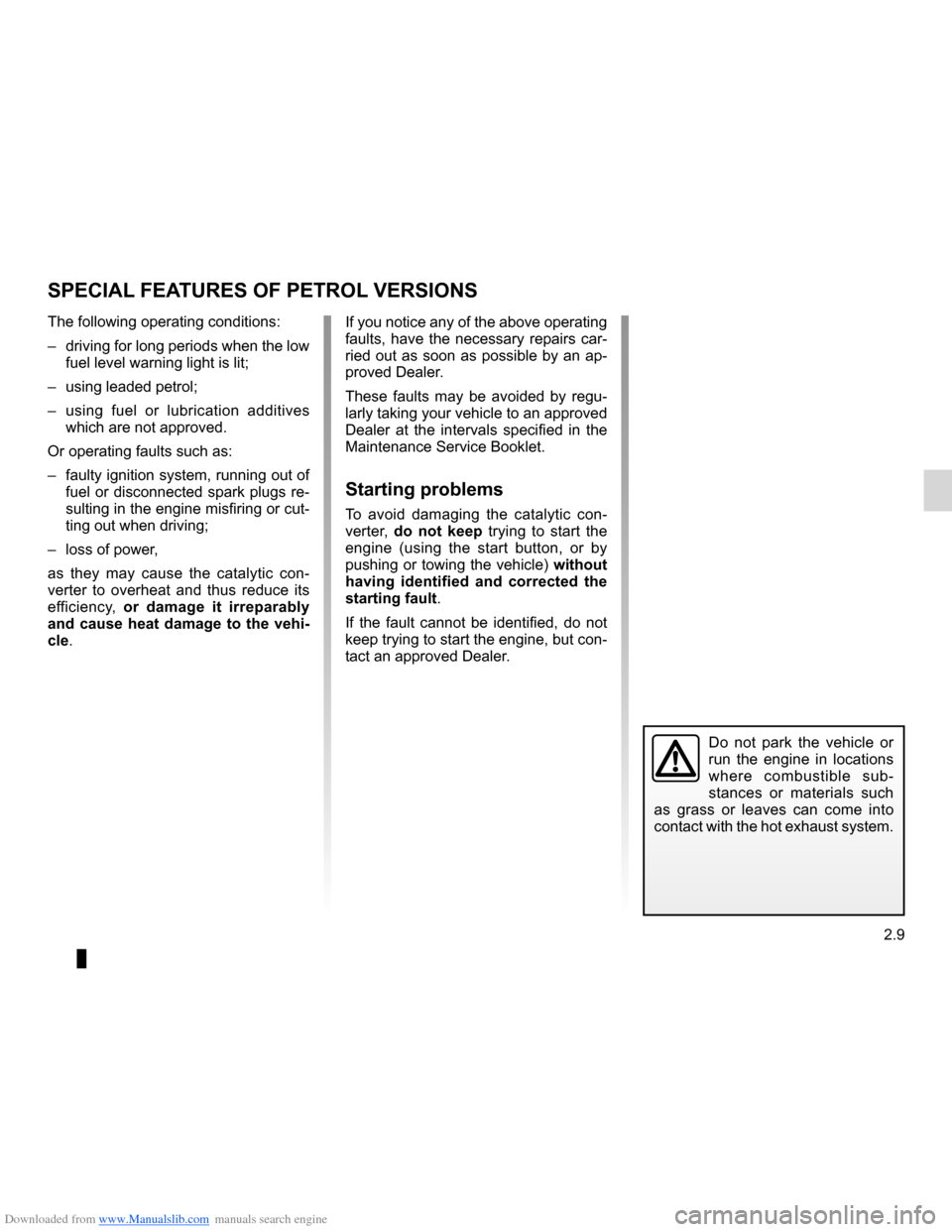
Downloaded from www.Manualslib.com manuals search engine special features of petrol vehicles ........ (up to the end of the DU)
catalytic converter ................................. (up to the end of the DU)
driving ................................................... (up to the end of the DU)
catalytic converter ................................. (up to the end of the DU)
2.9
ENG_UD10553_1
Particularités des versions essence (X85 - B85 - C85 - S85 - K85 - R\
enault)
ENG_NU_853-7_BCSK85_Renault_2
Special features of petrol versions
SPECIAL FEATURES OF PETROL VERSIONS
The following operating conditions:
– driving for long periods when the low
fuel level warning light is lit;
– using leaded petrol;
– using fuel or lubrication additives
which are not approved.
Or operating faults such as:
– faulty ignition system, running out of
fuel or disconnected spark plugs re-
sulting in the engine misfiring or cut-
ting out when driving;
– loss of power,
as they may cause the catalytic con -
verter to overheat and thus reduce its
efficiency, or damage it irreparably
and cause heat damage to the vehi-
cle. If you notice any of the above operating
faults, have the necessary repairs car-
ried out as soon as possible by an ap-
proved Dealer.
These faults may be avoided by regu
-
larly taking your vehicle to an approved
Dealer at the intervals specified in the
Maintenance Service Booklet.
Starting problems
To avoid damaging the catalytic con -
verter, do not keep trying to start the
engine (using the start button, or by
pushing or towing the vehicle) without
having identified and corrected the
starting fault.
If the fault cannot be identified, do not
keep trying to start the engine, but con-
tact an approved Dealer.
Do not park the vehicle or
run the engine in locations
where combustible sub -
stances or materials such
as grass or leaves can come into
contact with the hot exhaust system.
Page 105 of 268
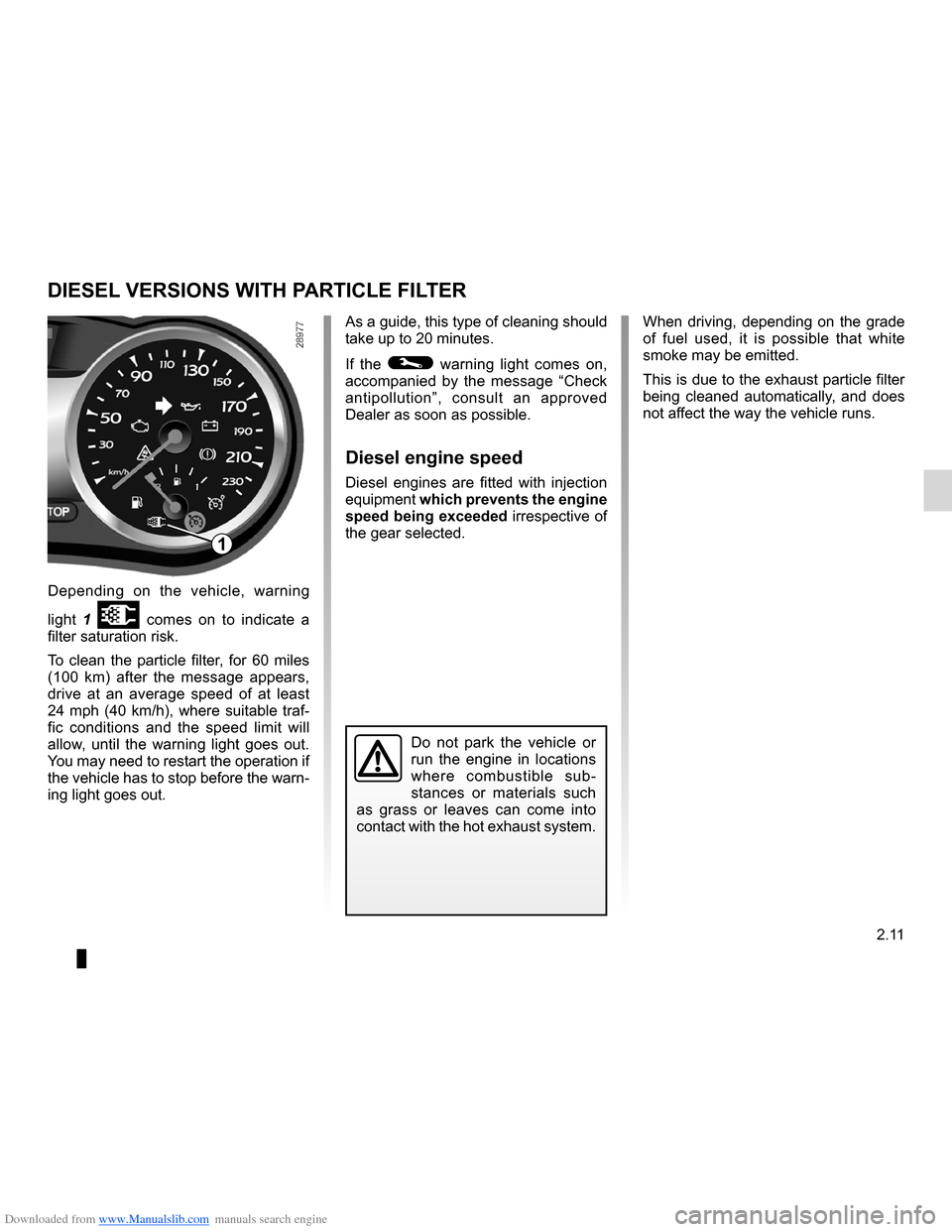
Downloaded from www.Manualslib.com manuals search engine driving ................................................... (up to the end of the DU)
filter particle filter .................................... (up to the end of the DU)
special features of diesel vehicles with particle filter
(up to the end of the DU)
2.11
ENG_UD19899_2
Particularités des versions diesel avec filtre à particules (X85 \
- B85 - C85 - S85 - K85 - Renault)
ENG_NU_853-7_BCSK85_Renault_2
As a guide, this type of cleaning should
take up to 20 minutes.
If the
© warning light comes on,
accompanied by the message “Check
antipollution”, consult an approved
Dealer as soon as possible.
Diesel engine speed
Diesel engines are fitted with injection
equipment which prevents the engine
speed being exceeded irrespective of
the gear selected.
Special features of diesel versions fitted with a particle filter
Do not park the vehicle or
run the engine in locations
where combustible sub -
stances or materials such
as grass or leaves can come into
contact with the hot exhaust system.
When driving, depending on the grade
of fuel used, it is possible that white
smoke may be emitted.
This is due to the exhaust particle filter
being cleaned automatically, and does
not affect the way the vehicle runs.
Depending on the vehicle, warning
light 1
Ü comes on to indicate a
filter saturation risk.
To clean the particle filter, for 60 miles
(100 km) after the message appears,
drive at an average speed of at least
24 mph (40 km/h), where suitable traf-
fic conditions and the speed limit will
allow, until the warning light goes out.
You may need to restart the operation if
the vehicle has to stop before the warn-
ing light goes out.
DIESEL VERSIONS WITH PARTICLE FILTER
1
Page 106 of 268
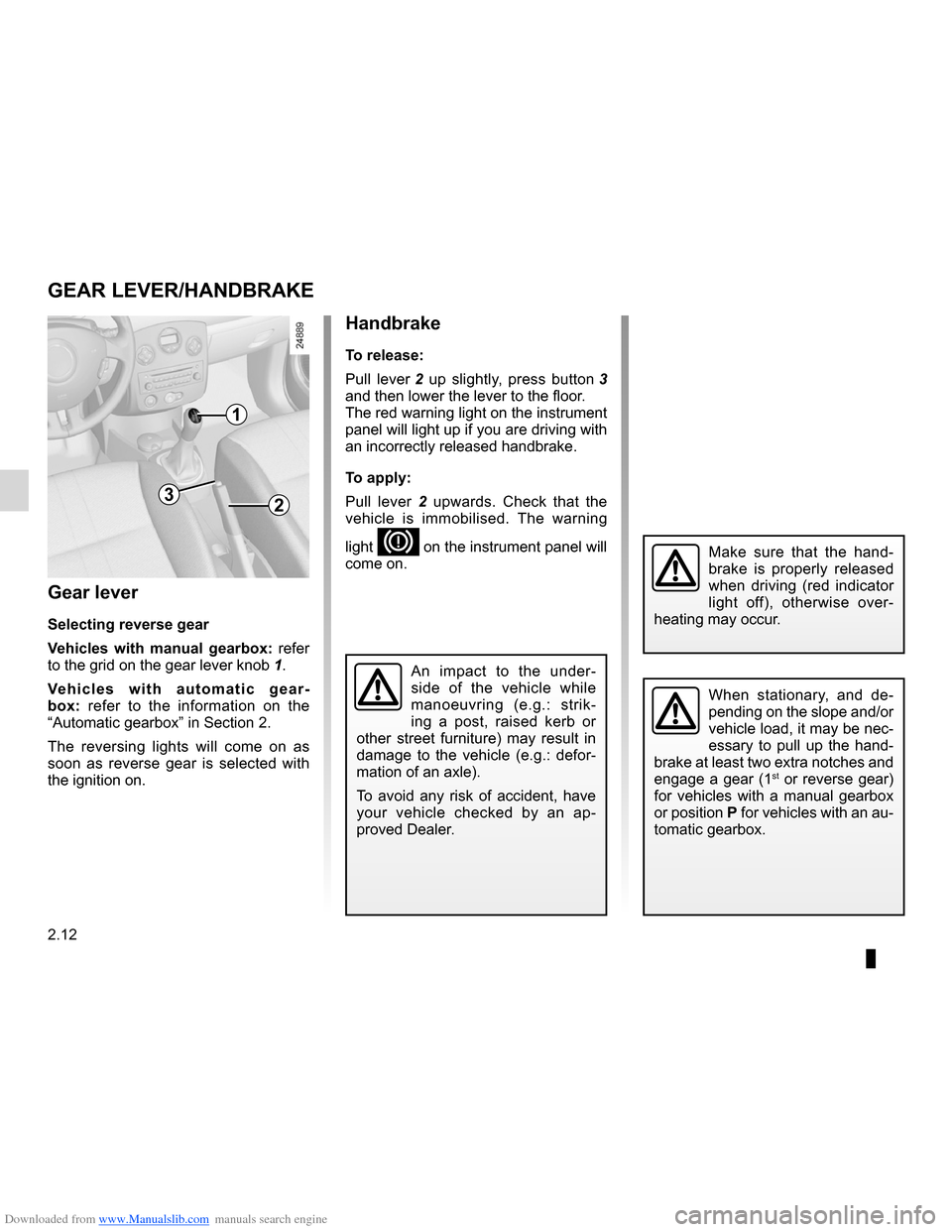
Downloaded from www.Manualslib.com manuals search engine gear lever............................................................... (current page)
reverse gear selecting .......................................... (up to the end of the DU)
handbrake .............................................................. (current page)
2.12
ENG_UD24920_3
Levier de vitesses/frein à main (X85 - B85 - C85 - S85 - K85 - Renau\
lt)
ENG_NU_853-7_BCSK85_Renault_2
Gear lever/Handbrake
Gear lever
Selecting reverse gear
Vehicles with manual gearbox: refer
to the grid on the gear lever knob 1.
Ve h i c l e s w i t h a u t o m a t i c g e a r -
box: refer to the information on the
“Automatic gearbox” in Section 2.
The reversing lights will come on as
soon as reverse gear is selected with
the ignition on.
1
GEAR LEVER/HANDBRAkE
Handbrake
To release:
Pull lever 2 up slightly, press button 3
and then lower the lever to the floor.
The red warning light on the instrument
panel will light up if you are driving with
an incorrectly released handbrake.
To apply:
Pull lever 2 upwards. Check that the
vehicle is immobilised. The warning
light
D on the instrument panel will
come on.
23
When stationary, and de -
pending on the slope and/or
vehicle load, it may be nec-
essary to pull up the hand -
brake at least two extra notches and
engage a gear (1
st or reverse gear)
for vehicles with a manual gearbox
or position P for vehicles with an au-
tomatic gearbox.
Make sure that the hand -
brake is properly released
when driving (red indicator
light off), otherwise over -
heating may occur.
An impact to the under -
side of the vehicle while
manoeuvring (e.g.: strik -
ing a post, raised kerb or
other street furniture) may result in
damage to the vehicle (e.g.: defor -
mation of an axle).
To avoid any risk of accident, have
your vehicle checked by an ap -
proved Dealer.
Page 108 of 268
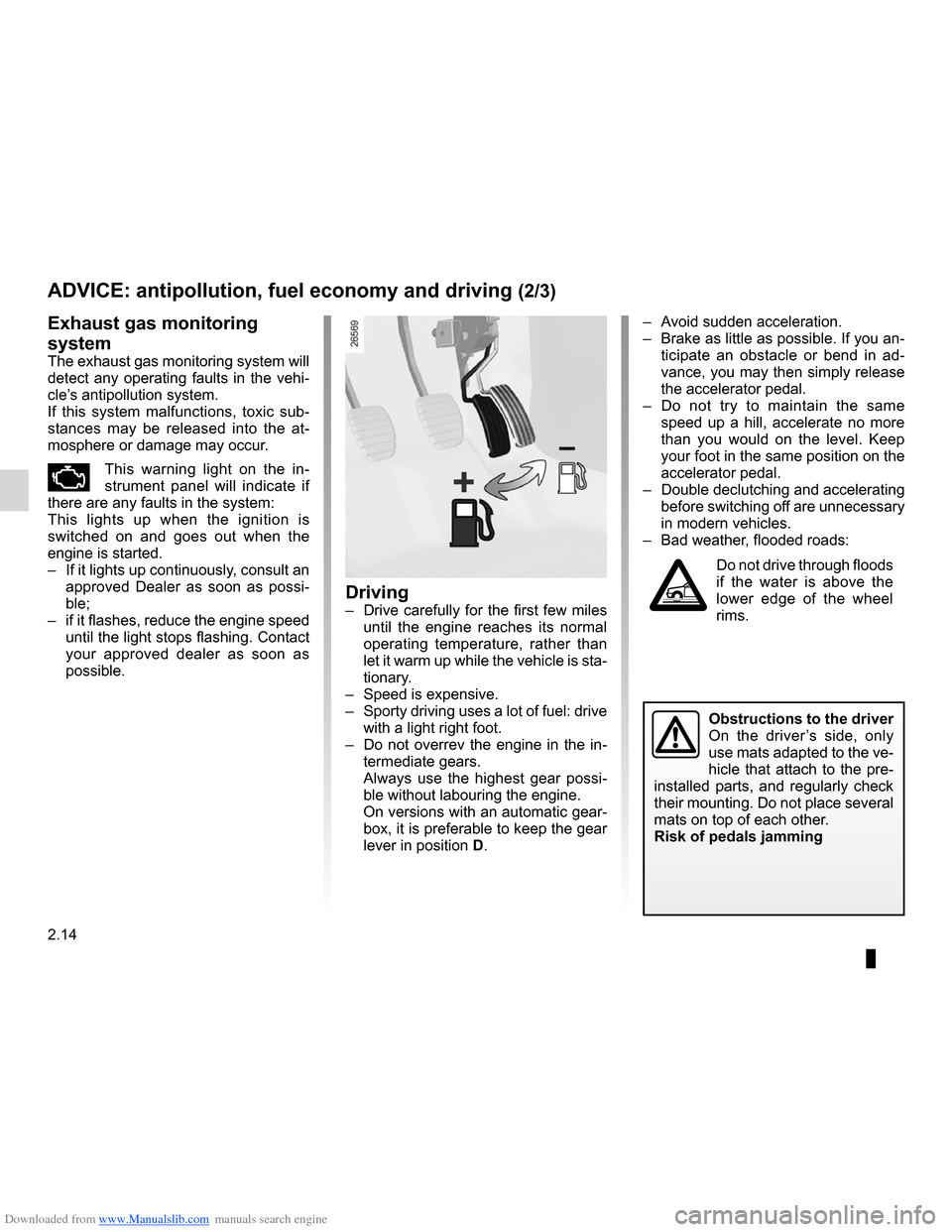
Downloaded from www.Manualslib.com manuals search engine 2.14
ENG_UD19886_6
Conseils antipollution, économie de carburant, conduite (X45 - H45 -\
X85 - B85 - C85 - S85 - X91 - X83 - X61 - F61 - K61 - K85 - X95 - B95 -\
D95 - J95 - R95 - L38 - X61
ENG_NU_853-7_BCSK85_Renault_2
Jaune NoirNoir texte
ADVICE: antipollution, fuel economy and driving (2/3)
– Avoid sudden acceleration.
– Brake as little as possible. If you an-
ticipate an obstacle or bend in ad -
vance, you may then simply release
the accelerator pedal.
– Do not try to maintain the same
speed up a hill, accelerate no more
than you would on the level. Keep
your foot in the same position on the
accelerator pedal.
– Double declutching and accelerating
before switching off are unnecessary
in modern vehicles.
– Bad weather, flooded roads:
Do not drive through floods
if the water is above the
lower edge of the wheel
rims.
Driving– Drive carefully for the first few miles
until the engine reaches its normal
operating temperature, rather than
let it warm up while the vehicle is sta-
tionary.
– Speed is expensive.
– Sporty driving uses a lot of fuel: drive
with a light right foot.
– Do not overrev the engine in the in-
termediate gears.
Always use the highest gear possi -
ble without labouring the engine.
On versions with an automatic gear-
box, it is preferable to keep the gear
lever in position D.
Exhaust gas monitoring
system
The exhaust gas monitoring system will
detect any operating faults in the vehi-
cle’s antipollution system.
If this system malfunctions, toxic sub -
stances may be released into the at -
mosphere or damage may occur.
ÄThis warning light on the in -
strument panel will indicate if
there are any faults in the system:
This lights up when the ignition is
switched on and goes out when the
engine is started.
– If it lights up continuously, consult an
approved Dealer as soon as possi -
ble;
– if it flashes, reduce the engine speed
until the light stops flashing. Contact
your approved dealer as soon as
possible.
Obstructions to the driver
On the driver ’s side, only
use mats adapted to the ve-
hicle that attach to the pre-
installed parts, and regularly check
their mounting. Do not place several
mats on top of each other.
Risk of pedals jamming
Page 112 of 268
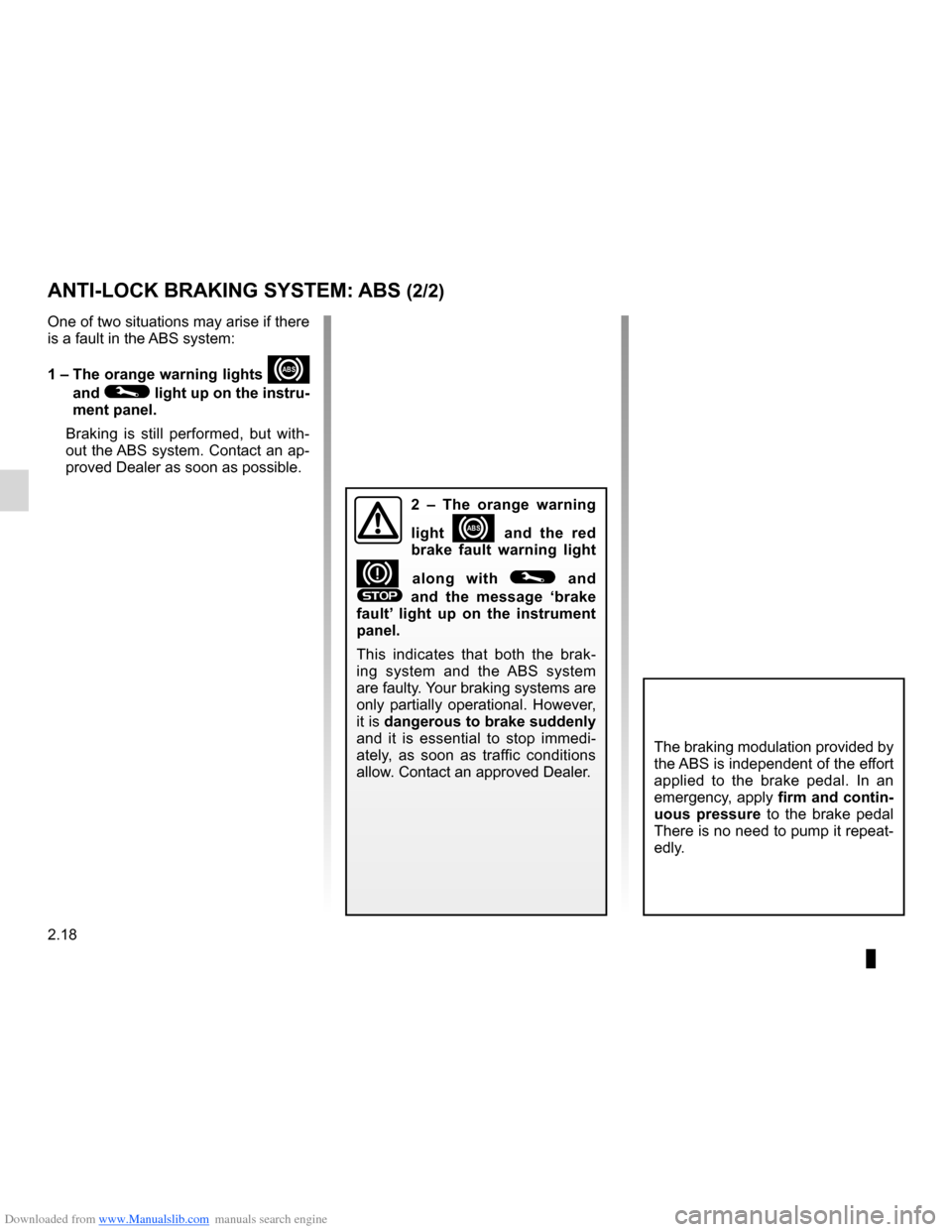
Downloaded from www.Manualslib.com manuals search engine 2.18
ENG_UD10561_1
Système antiblocage des roues : ABS (X85 - B85 - C85 - S85 - K85 - Renault)
ENG_NU_853-7_BCSK85_Renault_2
The braking modulation provided by
the ABS is independent of the effort
applied to the brake pedal. In an
emergency, apply firm and contin-
uous pressure to the brake pedal
There is no need to pump it repeat-
edly.
2 – The orange warning
light
x and the red
brake fault warning light
D along with © and
® and the message ‘brake
fault’ light up on the instrument
panel.
This indicates that both the brak -
ing system and the ABS system
are faulty. Your braking systems are
only partially operational. However,
it is dangerous to brake suddenly
and it is essential to stop immedi -
ately, as soon as traffic conditions
allow. Contact an approved Dealer.
One of two situations may arise if there
is a fault in the ABS system:
1 – The orange warning lights
x
and
© light up on the instru-
ment panel.
Braking is still performed, but with -
out the ABS system. Contact an ap-
proved Dealer as soon as possible.
ANTI-LOCk BRAkING SYSTEM: ABS (2/2)
Page 113 of 268
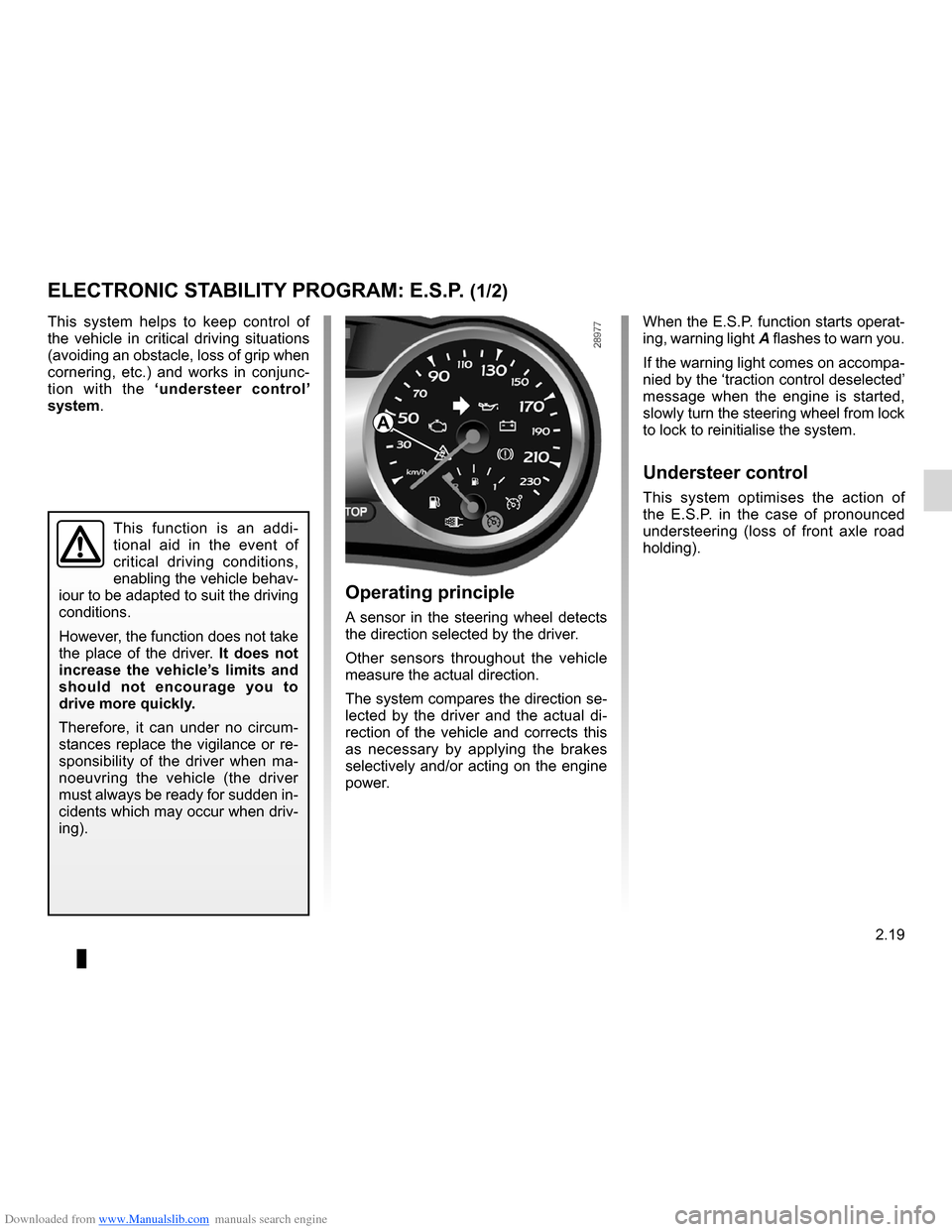
Downloaded from www.Manualslib.com manuals search engine driving ................................................... (up to the end of the DU)
Electronic Stability Program: ESP ........ (up to the end of the DU)
ESP: Electronic Stability Program ........ (up to the end of the DU)
2.19
ENG_UD10562_1
Contrôle dynamique de conduite : E.S.P. avec contrôle de sous-virage (X85 - B85 - C85 - S85 - K85 - Renaul\
t)
ENG_NU_853-7_BCSK85_Renault_2
This system helps to keep control of
the vehicle in critical driving situations
(avoiding an obstacle, loss of grip when
cornering, etc.) and works in conjunc -
tion with the ‘understeer control’
system .
Electronic Stability Program: ESP
This function is an addi -
tional aid in the event of
critical driving conditions,
enabling the vehicle behav -
iour to be adapted to suit the driving
conditions.
However, the function does not take
the place of the driver. It does not
increase the vehicle’s limits and
should not encourage you to
drive more quickly.
Therefore, it can under no circum -
stances replace the vigilance or re-
sponsibility of the driver when ma -
noeuvring the vehicle (the driver
must always be ready for sudden in-
cidents which may occur when driv-
ing).
When the E.S.P. function starts operat-
ing, warning light A flashes to warn you.
If the warning light comes on accompa -
nied by the ‘traction control deselected’
message when the engine is started,
slowly turn the steering wheel from lock
to lock to reinitialise the system.
Understeer control
This system optimises the action of
the E.S.P. in the case of pronounced
understeering (loss of front axle road
holding).
Operating principle
A sensor in the steering wheel detects
the direction selected by the driver.
Other sensors throughout the vehicle
measure the actual direction.
The system compares the direction se-
lected by the driver and the actual di -
rection of the vehicle and corrects this
as necessary by applying the brakes
selectively and/or acting on the engine
power.
ELECTRONIC STABILITY PROGRAM: E.S.P. (1/2)
A
Page 114 of 268
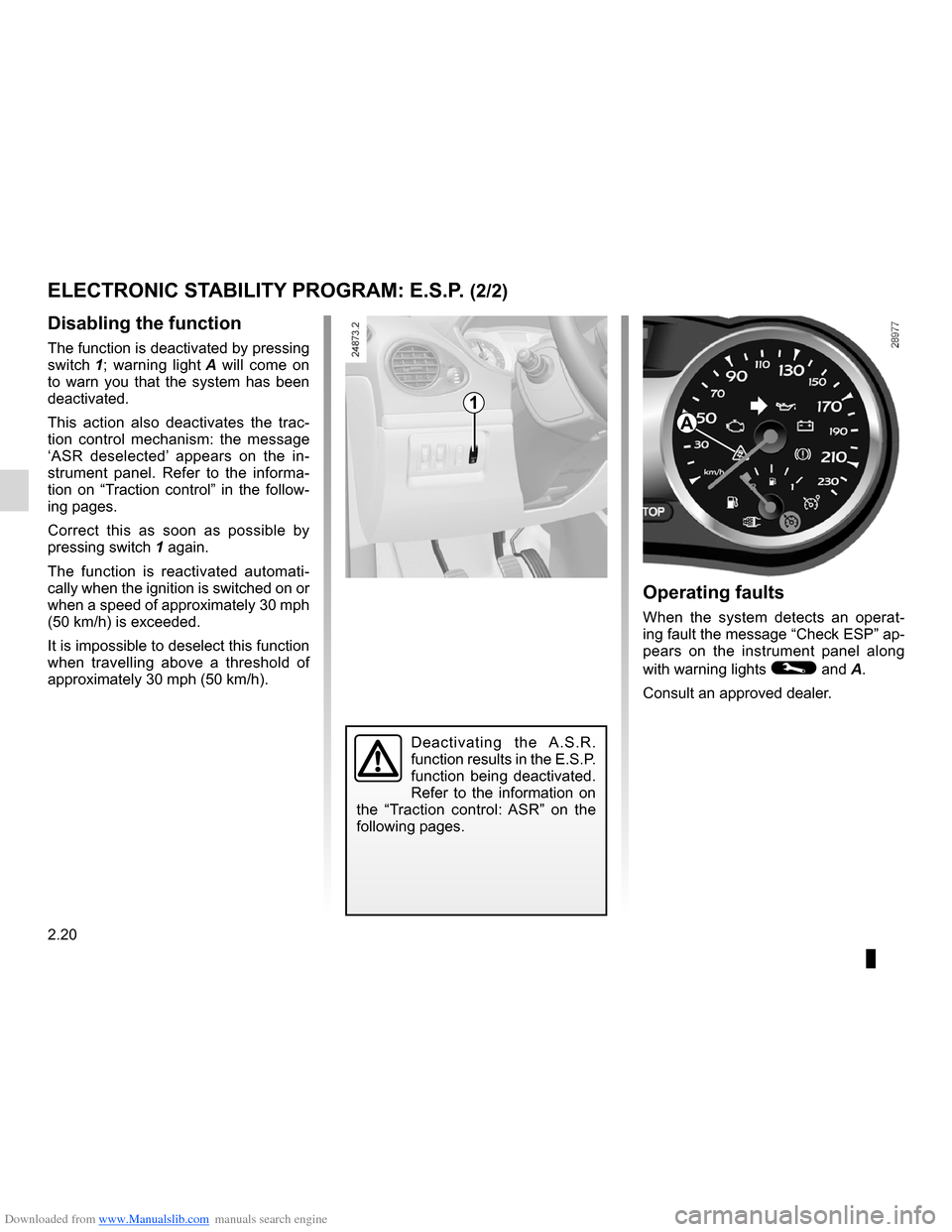
Downloaded from www.Manualslib.com manuals search engine 2.20
ENG_UD10562_1
Contrôle dynamique de conduite : E.S.P. avec contrôle de sous-virage (X85 - B85 - C85 - S85 - K85 - Renaul\
t)
ENG_NU_853-7_BCSK85_Renault_2
Deactivating the A.S.R.
function results in the E.S.P.
function being deactivated.
Refer to the information on
the “Traction control: ASR” on the
following pages.
Operating faults
When the system detects an operat -
ing fault the message “Check ESP” ap-
pears on the instrument panel along
with warning lights
© and A.
Consult an approved dealer.
Disabling the function
The function is deactivated by pressing
switch 1 ; warning light A will come on
to warn you that the system has been
deactivated.
This action also deactivates the trac -
tion control mechanism: the message
‘ASR deselected’ appears on the in -
strument panel. Refer to the informa -
tion on “Traction control” in the follow -
ing pages.
Correct this as soon as possible by
pressing switch 1 again.
The function is reactivated automati -
cally when the ignition is switched on or
when a speed of approximately 30 mph
(50 km/h) is exceeded.
It is impossible to deselect this function
when travelling above a threshold of
approximately 30 mph (50 km/h).
ELECTRONIC STABILITY PROGRAM: E.S.P. (2/2)
A
1
Page 115 of 268

Downloaded from www.Manualslib.com manuals search engine traction control: ASR .............................(up to the end of the DU)
driving ................................................... (up to the end of the DU)
traction control: ASR .............................(up to the end of the DU)
2.21
ENG_UD10563_1
Système antipatinage : A.S.R. (X85 - B85 - C85 - S85 - K85 - Renault)
ENG_NU_853-7_BCSK85_Renault_2
Traction control: ASR
This function is an addi -
tional aid in the event of
critical driving conditions,
enabling the vehicle behav -
iour to be adapted to suit the driving
conditions.
However, the function does not take
the place of the driver. It does not
increase the vehicle’s limits and
should not encourage you to
drive more quickly.
Therefore, it can under no circum -
stances replace the vigilance or re-
sponsibility of the driver when ma -
noeuvring the vehicle (the driver
must always be ready for sudden in-
cidents which may occur when driv-
ing).
The system also adjusts the engine
speed to the grip available under the
wheels, independently of the pressure
exerted on the accelerator pedal.
When the function begins to operate,
warning light A flashes to warn you.
If the warning light comes on accompa -
nied by the ‘traction control deselected’
message when the engine is started,
slowly turn the steering wheel from lock
to lock to reinitialise the system.
Operating principle
Using the wheel sensors, the system
measures and compares the speed of
the drive wheels at all times and slows
down their over-rotation.
If a wheel is starting to slip, the system
brakes automatically until the drive sup-
plied becomes compatible with the level
of grip under the wheel again.
This system helps to limit skidding on
drive wheels and to control the vehicle
when pulling away or accelerating.
TRACTION CONTROL: A.S.R. (1/2)
A
Page 116 of 268

Downloaded from www.Manualslib.com manuals search engine 2.22
ENG_UD10563_1
Système antipatinage : A.S.R. (X85 - B85 - C85 - S85 - K85 - Renault)
ENG_NU_853-7_BCSK85_Renault_2
Deactivating the A.S.R.
function results in the E.S.P.
function being deactivated.
Refer to the information on
the “Electronic stability program:
E.S.P.” on the following pages.
Operating faults
When the system detects an operat -
ing fault the message “Check E.S.P.”
appears on the instrument panel along
with the
© warning light and warn-
ing light A.
Consult an approved dealer.
Disabling the function
In some situations (driving on very wet
ground: snow, mud, etc. or driving with
snow chains fitted), the system may
reduce the engine output to limit wheel -
spin. If this is not required, it is possible
to deactivate the function by pressing
switch 1.
The ‘traction control deselected’ mes -
sage is displayed on the instrument
panel along with warning light A to
inform you.
Disabling the function also disables
the E.S.P. function.
Correct this as soon as possible by
pressing switch 1 again.
The function is reactivated automati -
cally when the ignition is switched on or
when a speed of approximately 30 mph
(50 km/h) is exceeded.
It is impossible to deselect this function
when travelling above a threshold of
approximately 30 mph (50 km/h).
TRACTION CONTROL: A.S.R. (2/2)
1
A